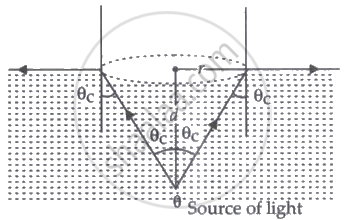Advertisements
Advertisements
प्रश्न
| A ray of light travels from a denser to a rarer medium. After refraction, it bends away from the normal. When we keep increasing the angle of incidence, the angle of refraction also increases till the refracted ray grazes along the interface of two media. The angle of incidence for which it happens is called critical angle. If the angle of incidence is increased further the ray will not emerge and it will be reflected back in the denser medium. This phenomenon is called total internal reflection of light. |
A point source of light is placed at the bottom of a tank filled with water, of refractive index µ, to a depth d. The area of the surface of water through which light from the source can emerge is:
विकल्प
`(π"d"^2)/(2(µ^2 - 1))`
`(π"d"^2)/((µ^2 - 1))`
`(π"d"^2)/(sqrt2 sqrt(µ^2 - 1))`
`(2π"d"^2)/((µ^2 - 1))`
उत्तर
`bb(("πd"^2)/((µ^2 - 1)))`
Explanation:
r = d tan θc
sin θc = `1/µ`
∴ cos θc = `sqrt(1 - 1/µ^2)`
∴ r = `"d"(1//µ)/(sqrt(µ^2 - 1)/µ) = "d"/sqrt(µ^2 - 1)`
∴ area = πr2 = `(π"d"^2)/(µ^2 - 1)`

APPEARS IN
संबंधित प्रश्न
Consider Galileo's method of measuring the speed of light using two lanterns. To get an accuracy of about 10%, the time taken by the experimenter in closing or opening the shutter should be about one tenth of the time taken by the light in going from one experimenter to the other. Assume that it takes 1/100 second for an experimenter to close or open the shutter. How far should the two experimenters be to get a 10% accuracy? What are the difficulties in having this separation?
In Fizeau method of measuring the speed of light, the toothed wheel is placed in the focal plane of a converging lens. How would the experiment be affected if the wheel is slightly away from the focal plane?
In the original Fizeau method, the light travelled 8.6 km and then returned. What could be the difficulty if this distance is taken as 8.6 m?
What is the advantage of using a polygonal mirror with larger number of faces in Michelson method of measuring the speed of light?
Which of the following methods can be used to measure the speed of light in water?
In a Michelson experiment for measuring speed of light, the distance travelled by light between two reflections from the rotating mirror is 4.8 km. The rotating mirror has a shape of a regular octagon. At what minimum angular speed of the mirror (other than zero) the image is formed at the position where a nonrotating mirror forms it?
What is the speed of light in a denser medium of polarizing angle 30?
When a biconvex lens of glass having refractive index 1.47 is dipped in a liquid, it acts as a plane sheet of glass. This implies that the liquid must have refractive index.
A beam of light consisting of red, green and blue is incident on a right-angled prism as shown in figure. The refractive index of the material of the prism for the above red, green and blue colours are 1.39, 1.44 and 1.47 respectively. What are the colours suffer total internal reflection?

| A ray of light travels from a denser to a rarer medium. After refraction, it bends away from the normal. When we keep increasing the angle of incidence, the angle of refraction also increases till the refracted ray grazes along the interface of two media. The angle of incidence for which it happens is called critical angle. If the angle of incidence is increased further the ray will not emerge and it will be reflected back in the denser medium. This phenomenon is called total internal reflection of light. |
The critical angle of the pair of a medium and air is 30°. The speed of light in the medium is:
